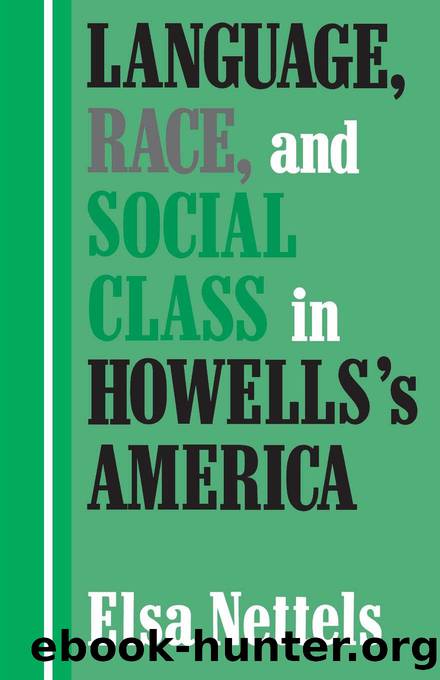Language, Race, and Social Class in Howells's America by Nettels Elsa;

Author:Nettels, Elsa; [Nettels Elsa]
Language: eng
Format: epub
Publisher: University Press of Kentucky
Published: 2021-08-15T00:00:00+00:00
Chapter Eight
Language and Class in Novels of Country and City
When Henry James praised Howellsâs early novels, he often expressed his faith in his friendâs power to go farther, to convert into literature more of the American experience. He pronounced The Lady of the Aroostook âthe most brilliant thing you have done,â then urged Howells to âattack the great field of American life on as many sides as you can. Plunge into it, donât be afraid, and you will do even better things than this.â Several months later, in a letter dated July 22, 1879, when he had learned of the subject of Howellsâs next novel, The Undiscovered Country, centering on the relationships of a spiritualist, his daughter, and her lover, he commended the donnée as âvery promising,â although he confessed âan intense aversion to spiritualistic material which has always seemed to me terribly sordid and dreary.â (Several years later he would convert such material into the brilliant satire of The Bostonians.) âBut your subject has the merit of being real, actual and American, and this is a great quality,â he concluded. âContinue to Americanize and to realize: that is your mission;âand if you stick to it you will become the Zola of the U.S.A.âwhich I consider a great function.â After reading the first installment of The Undiscovered Country in the Atlantic, January 1880, he wrote enthusiastically to Howells: âYou have something really new and unworked.â He thought the conception of Egeria, the spiritualistâs daughter, âa most interesting inventionâa real trouvaille.â1
Egeria, whose mesmeric trances symbolize her surrender to her fatherâs will, derives from Priscilla in The Blithedale Romance, Howellsâs favorite of Hawthorneâs works. Dr. Boynton, blinded by his obsession until near death, when he condemns himself a vampire for his coercion of his daughter, has attributes of Priscillaâs masters, Westervelt and Hollingsworth, as well as Hawthorneâs Faustian scientists, such as Aylmer and Rappaccini, whose victims are beautiful young women.2 Boyntonâs antagonist, the journalist Ford, who eventually marries Egeria, somewhat resembles Holgrave in The House of the Seven Gables, as Egeria, in her association with light, brightness, and the healing influences of nature, resembles Phoebe Pyncheon. Possible antecedents of Dr. Boynton, Egeria, and Ford also include the scientist Gifford, his daughter, and the mesmerist-medium in Jamesâs story âProfessor Fargo.â Egeria shares with Kitty Ellison and Lydia Blood physical beauty, moral purity, normal emotions, and the power to reclaim young men, at least temporarily, from the barrenness of snobbery or cynicism.
What are ânew and unworkedâ in The Undiscovered Country are not the roles of the three central characters but their relationship to realistically conceived settingsâBoston, the New England countryside, and the Shaker village, where the characters of romance origins encounter a greater variety of social types than Howells had yet portrayed. For the first time, he set main portions of a novel in a city, making Mrs. LeRoyâs seedy boarding house, where a dozen people gather in the first scene for a séance, a microcosm of Bostonâs class structure. The lapses in the taste and grammar of Mrs.
Download
This site does not store any files on its server. We only index and link to content provided by other sites. Please contact the content providers to delete copyright contents if any and email us, we'll remove relevant links or contents immediately.
The Power of Myth by Joseph Campbell & Bill Moyers(1013)
Half Moon Bay by Jonathan Kellerman & Jesse Kellerman(954)
Inseparable by Emma Donoghue(937)
A Social History of the Media by Peter Burke & Peter Burke(936)
The Nets of Modernism: Henry James, Virginia Woolf, James Joyce, and Sigmund Freud by Maud Ellmann(836)
The Spike by Mark Humphries;(766)
The Complete Correspondence 1928-1940 by Theodor W. Adorno & Walter Benjamin(749)
A Theory of Narrative Drawing by Simon Grennan(742)
Culture by Terry Eagleton(724)
Ideology by Eagleton Terry;(696)
Bodies from the Library 3 by Tony Medawar(682)
World Philology by(678)
Farnsworth's Classical English Rhetoric by Ward Farnsworth(674)
Game of Thrones and Philosophy by William Irwin(671)
High Albania by M. Edith Durham(659)
Adam Smith by Jonathan Conlin(648)
A Reader’s Companion to J. D. Salinger’s The Catcher in the Rye by Peter Beidler(646)
Comic Genius: Portraits of Funny People by(616)
Monkey King by Wu Cheng'en(611)
